Preparation for Presenter: Using cutouts of different shapes (see attachment below) make shapes you can use on the flannel board. If you want to play the matching game in addition to talking about shapes, make more than one of each shape.
Introduction: Today we talked about shapes and alike and different. So let’s see what shapes you see up here. Depending on the size, age-level and attention span of the group, you can put the shapes up yourself or hand them out to the toddlers and have them put the shapes up on the flannel board. Say the name of the shape as well as some additional description. For example, "Here is a circle, a small blue circle.” Have the children repeat the name of the shape and/or the description.]
Early Literacy Aside--Example: Helping your child notice and talk about shapes later helps them identify letters. When you think of an upper case A, there is a triangle shape in it. For Matching Game: You keep one copy of each shape and pass out the additional copies of the shapes. Put up one shape, say what it is and describe it. Then have those children who have the same shape come up to the flannel board to add theirs to yours. Don't forget to clap for each person. Adults are welcome to help their children.
Early Literacy Aside--Example: Playing matching games helps your child notice what is alike and different. This is one part of developing letter knowledge.
Matching Game Variation: You can make the matching more challenging by making patterns on your shapes. For example, you may color a couple of circles on a square, or make a design on two copies of the same shape. You can make the matching more or less challenging by how intricate or obvious the differences are. Use the handout of shapes for parents and children to cut out and play with at home. Early Literacy Aside for Shape Handout--Empower: This handout has several shapes you can cut out at home. You can use them as patterns and cut them out of different color paper. You can draw on them to make different patterns to match as well. You might ask your toddler to put all the circles together, all the ones with straight lines, all the ones with the same color. Sorting is one way of noticing what is alike and different. When children try to recognize letters they will need this skill. Think of a lower case h and a lower case n. They look similar but they are also different.
Alphabet Song
Early Literacy Aside--Example: Singing the alphabet song is one way to introduce children to letters. Part of letter knowledge, one of the early literacy skills that helps children be ready to read in school, is knowing the names of letters. At first your child may not relate the letters they sing to the written letter. That's ok; this is a first step.The alphabet song is to the tune of Twinkle, Twinkle, Little Star.
Sing Alphabet Song. Now let's sing it again to the tune of Mary Had a Little Lamb. The letters come out in a different rhythm. They are less likely to lump l m n o together. Sing Alphabet Song again to new tune.
Color Zoo by Lois Ehlert
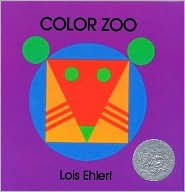
Early Literacy Aside--Explain: The beginning of letter knowledge, one of the six early literacy skills, is seeing and recognizing shapes. Researchers have found that children learn to recognize letters by their shapes. I'll be pointing out some ways that you can use books to talk about shapes.
Early Literacy Aside--Example: Our next book is Color Zoo by Lois Ehlert. It is really fascinating how you can see the animals just using basic shapes. What animals do you see? Sharing books with stark shapes like this is a first step to recognizing letters later. Read the book. Talk about the shapes as well as the animals. The back of the book are the separate shapes which you can also point out or refer to from time to time as you read the book.
Early Literacy Aside--Empower: This is quite a sophisticated book and can be used in many ways with very young children and also as your children get older. Start with simply noticing shapes and bright colors and your older children can make animals from shapes themselves.
Opening Song for Adult Introduction
Here's a song to encourage parents/caregivers to participate in the storytime.Storytime Announcement (Tune: Yankee Doodle)
Please turn down your cell phones now,
So they will not distract us.
Please join along and sing the songs,
It always helps to practice.
Storytime can help us read.
Storytime is what we need.
Storytime is lots of fun!
Storytime's for everyone.
Early Literacy Aside: Explain: When you participate in our storytime activities, you help to show your children the joy of books, reading, and other language-building activities. They recognize that YOU, the important person in their lives, thinks storytime is important. You help support print motivation, your child's enjoyment of reading, which will later help them stick with learning to read even if it is hard for them.
Submitted by Mary Binda, Augusta County (VA) Public Library
I'm Taking a Trip on My Train by Shirley Neitzel
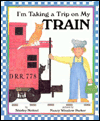
Introduce book: This book about a train uses pictures for for some words. You can help me by filling in the words when you see the picture.Read book: As you read the book, point to the pictures in the text so that the participants (children and adults) will chime in with the appropriate words.
Early Literacy Aside--Example: (Print Awareness) As you point to the pictures and have children say the words, you are helping them see that pictures represent words. This is the beginning to helping them understand that the written word also represents the words we say. Print awareness is one of the skills children need to be able to learn to read and you are helping to develop this skill when you point to pictures and words as you say words.
Early Literacy Aside--Empower: (for Print Awareness) Having words as part of the text of the story is a fun way to write stories with your child. As your child tells you a story, you can write it down and let them draw pictures for some of the repeated words. They see the written words for their spoken words which develops print awareness.
Early Literacy Aside--Example: (for Narrative Skills) Having your young children chime in with a word or phrase, as much as they can remember, is a first step to being able to retell the whole story. Retelling stories helps children develop narrative skills which later helps them understand what they read.
Early Literacy Aside--Empower: (Narrative Skills) This is a cumulative story, where the lines are repeated. Having your child say the repeated phrases helps to develop retelling the story which develops their narrative skills, one of the skills that helps with later reading. Retelling stories helps develop their understanding of the story as well.
Choose only one skill to highlight (to say the aside).
Big Chickens Go To Town by Leslie Helakoski
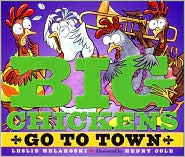
Introduction to book: Our next book is Big Chickens Go to Town by Leslie Helakoski. There are a couple of other Big Chicken books and I think they are very funny. See what you think.
Read the book taking your cue for voice expression from the pictures.
Early Literacy Aside--Example (for Vocabulary): This book has so many interesting words. Use them all, like "the chickens bawled, squalled and caterwauled." This is how your child's vocabulary will grow. Even if they (or you) don't understand every word, you can get the idea from the story itself. That's one of the wonderful things about books, they have so many interesting words.
Early Literacy Aside--Example (for Phonological Awareness): This book has many rhyming words. [Demonstrate with one page. For example, reread the page that starts Shouting voices wobbled.] Wobbled rhymes with bobbled. Flumped rhymes with bumped and rushed rhymes with crushed. Let's think of some other words that rhyme with crushed. They don't even have to make sense. (mushed, brushed, zushed) Pointing out and making rhyming words helps to develop one of the early literacy skills called phonological awareness--hearing the smaller sounds in words. This will later help your child sound out words when they learn to read.
Choose only one skill to highlight (to say the aside).
Spider on the Floor by Raffi

Read Spider on the Floor by Raffi or use the Raffi recording on Singable Songs for the Very Young.You can add verses with less familiar parts of the body.
Activity: Give each child a plastic or rubbery spider. As the song progresses have them put their spiders on the correct body part until it jumps back on the floor. (Shopping for spiders around Halloween is the best time for getting creepy rubbery spiders.)
Early Literacy Aside--Example: Using props during a song or story that prompts children to act out the meaning of the words, provides children with a fun and active way to learn new words and to practice their vocabulary skills.
Submitted by Kathleen Moore, Dayton (OH) Metro Library System
Song for Introduction
Storytime Announcement (tune: Yankee Doodle)
Please turn down your cell phones now,
So they will not distract us.
Please join along and sing the songs,
It always helps to practice.
Storytime can help us read.
Storytime is what we need.
Storytime is lots of fun!
Storytime’s for everyone.
EarlyLiteracy Aside--Explain: When you participate in storytime with your children you send them the message that what we do in storytime is important. You let them know that reading is important and enjoyable, worth doing. They love to do things with you. By being present you help to support their print motivation, their enjoyment of books and reading. This will later help them stick with learning to read even if it is difficult for them.
Submitted by Mary Binda, Augusta County (VA) Public Library
Scarecrow, Scarecrow Rhyme and Dance
 Early Literacy Aside--Explain: Here's a rhyme that you can do anytime and it reinforces rhyming words which develops phonological awareness while having fun at the same time.Do Scarecrow, Scarecrow activity
Children stand up with arms bent at elbows like a scarecrow and head tilted. Actions to words.
Scarecrow, Scarecrow, turn around
Scarecrow, Scarecrow, jump up and down
Scarecrow, Scarecrow, raise your arms high
Scarecrow, Scarecrow, wink one eye
Scarecrow, Scarecrow, bend your knees
Scarecrow, Scarecrow, flap in the breeze
Scarecrow, Scarecrow, climb into bed
Scarecrow, Scarecrow, rest your head.
Early Literacy Aside--Explain: Here's a rhyme that you can do anytime and it reinforces rhyming words which develops phonological awareness while having fun at the same time.Do Scarecrow, Scarecrow activity
Children stand up with arms bent at elbows like a scarecrow and head tilted. Actions to words.
Scarecrow, Scarecrow, turn around
Scarecrow, Scarecrow, jump up and down
Scarecrow, Scarecrow, raise your arms high
Scarecrow, Scarecrow, wink one eye
Scarecrow, Scarecrow, bend your knees
Scarecrow, Scarecrow, flap in the breeze
Scarecrow, Scarecrow, climb into bed
Scarecrow, Scarecrow, rest your head.
Submitted by Terri Stringer, Vandalia Branch, Dayton Metro (OH) Public Library
Now Matter What by Emma Dodd
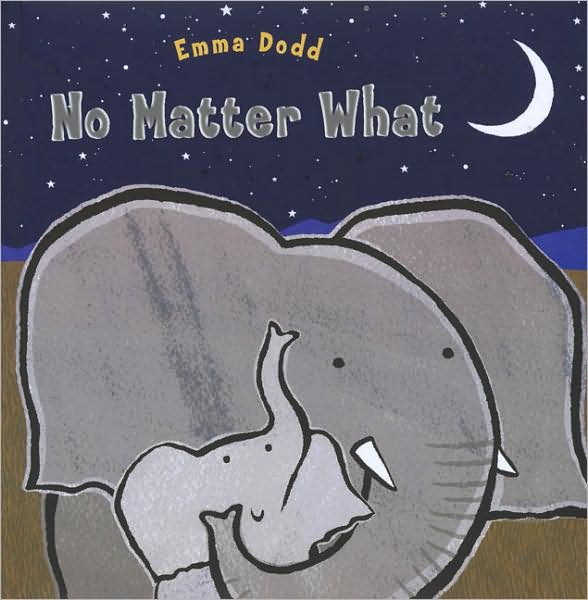 Earlly Literacy Aside--Explain: Welcome. Today we are going to have stories that have elephants in them. [Show elephant puppet] I am also going to highlight vocabulary as a fun way to help your child get ready to read. The more words they know, the easier it will be for them to understand what they read and also to make sense of words as they sound out words.Early Literacy Aside--Example: Very young children learn the names of things they see or see pictures of, like elephant, flowers, mouse. As they get older they understand words for feelings and concepts like sad, happy, good, bad, big elephant, little elephant. And older still, they understand words for ideas like brave, kind, mean. These are examples of ways you can develop your child's vocabulary daily in a fun way. You can use books to help develop all levels of vocabulary. Listen to some of the words as I read our next book.
Read No Matter What
Early Literacy Aside--Empower: The library has many books with opposites, feelings, and other concepts to help you have fun with vocabulary development with your child. Books from naming items to talking about ideas. Just ask us for some suggestions.
Earlly Literacy Aside--Explain: Welcome. Today we are going to have stories that have elephants in them. [Show elephant puppet] I am also going to highlight vocabulary as a fun way to help your child get ready to read. The more words they know, the easier it will be for them to understand what they read and also to make sense of words as they sound out words.Early Literacy Aside--Example: Very young children learn the names of things they see or see pictures of, like elephant, flowers, mouse. As they get older they understand words for feelings and concepts like sad, happy, good, bad, big elephant, little elephant. And older still, they understand words for ideas like brave, kind, mean. These are examples of ways you can develop your child's vocabulary daily in a fun way. You can use books to help develop all levels of vocabulary. Listen to some of the words as I read our next book.
Read No Matter What
Early Literacy Aside--Empower: The library has many books with opposites, feelings, and other concepts to help you have fun with vocabulary development with your child. Books from naming items to talking about ideas. Just ask us for some suggestions.
Submitted by Jeanenne Robinson, Public Library of Charlotte and Mechlenburg County (NC)
Dog's Day by Jane Cabrera
 Read Dog's Day. As you point to the title also point out the letter D in Dog and Day.Early Literacy Aside--Example: Help your children find letters based on the subjects they like. D is the first letter in dog. If your child is interest in trucks, you can point out the letter t.
Early Literacy Aside--Empower: Remember that letters are everywhere! Have your child make letters with their fingers, whole body, or playdough.
Read Dog's Day. As you point to the title also point out the letter D in Dog and Day.Early Literacy Aside--Example: Help your children find letters based on the subjects they like. D is the first letter in dog. If your child is interest in trucks, you can point out the letter t.
Early Literacy Aside--Empower: Remember that letters are everywhere! Have your child make letters with their fingers, whole body, or playdough.
Submitted by Emily Leachman, Public Library of Charlotte and Mechlenburg County (NC)
Pigeon books by Mo Willems
 Early Literacy Aside--Explain: Print motivation is an interest in and enjoyment of books and reading. It is one of the early literacy skills that researchers say are important for children to have before they learn to read. Choose books that you enjoy. Your child picks up on your feelings and understands the enjoyment of books and reading.Read several of the "pigeon" books during the storytime, having fun with them in different ways: acting them out, predicting outcomes, singing "The Pigeon on the Bus" to the tune of "The Wheels on the Bus", drawing a pigeon, etc.
Early Literacy Aside--Example: Parents, you can see we are building on the book to add to the enjoyment of sharing the book itself. You know your child best and you can use your child's interests to build on the books you read together.
Early Literacy Aside--Empower: You may not realize it but by sharing books you and your child enjoy, you are helping to develop your child's print motivation. So, every day continue to share books that you enjoy with your child.
Early Literacy Aside--Explain: Print motivation is an interest in and enjoyment of books and reading. It is one of the early literacy skills that researchers say are important for children to have before they learn to read. Choose books that you enjoy. Your child picks up on your feelings and understands the enjoyment of books and reading.Read several of the "pigeon" books during the storytime, having fun with them in different ways: acting them out, predicting outcomes, singing "The Pigeon on the Bus" to the tune of "The Wheels on the Bus", drawing a pigeon, etc.
Early Literacy Aside--Example: Parents, you can see we are building on the book to add to the enjoyment of sharing the book itself. You know your child best and you can use your child's interests to build on the books you read together.
Early Literacy Aside--Empower: You may not realize it but by sharing books you and your child enjoy, you are helping to develop your child's print motivation. So, every day continue to share books that you enjoy with your child.
Submitted by Susan Blombert, Sugar Creek Branch, Public Library of Charlotte and Mechlenburg County (NC)
Down by the Cool of the Pool by Tony Milton
 Early Literacy Aside--Explain: Researchers have noted one of the areas of early literacy to be print motivation. This means having an interest in and enjoying books. Children are more likely to have print otivation when they are involved with the story. As I share books today, you'll see different ways you can keep your children interested as you read with them.Read Down by the Cool of the Pool
Early Literacy Aside--Example: Having a child say a repeated phrase with you throughout the book keeps him involved and it's an easy way to you to support print motivation.
Early Literacy Aside--Empower: Remember that promoting literacy does not mean creating a school-like setting in your home, but rather taking advantage of the opportunities in your everyday life.
Submitted by Emily Little, Public Library of Charlotte and Mechlenburg County (NC)
Early Literacy Aside--Explain: Researchers have noted one of the areas of early literacy to be print motivation. This means having an interest in and enjoying books. Children are more likely to have print otivation when they are involved with the story. As I share books today, you'll see different ways you can keep your children interested as you read with them.Read Down by the Cool of the Pool
Early Literacy Aside--Example: Having a child say a repeated phrase with you throughout the book keeps him involved and it's an easy way to you to support print motivation.
Early Literacy Aside--Empower: Remember that promoting literacy does not mean creating a school-like setting in your home, but rather taking advantage of the opportunities in your everyday life.
Submitted by Emily Little, Public Library of Charlotte and Mechlenburg County (NC)
Mama Cat Has Three Kittens by Denise Fleming
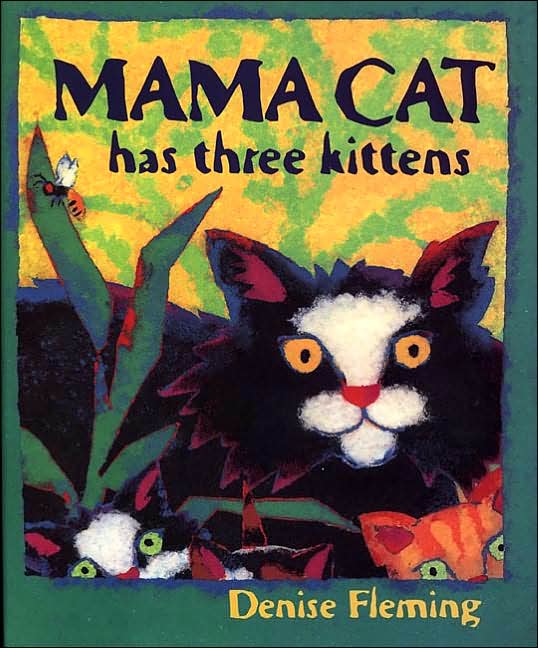 Cat Puppet: There's a cat in my hat, a cat in my hat, a cat in my hat today (do twice). What does the kitty cat say? [cat puppet says meow]Read Mama Cat Has Three Kittens
Early Literacy Aside--Example: When children hear rhymes, rhythms and sounds of animals, it helps them develop phonological awareness, hearing the smaller sounds in words. This is a skill that will help them as they begin to read.
Early Literacy Aside--Empower: Keep doing rhymes with things in your children's world. Today we did cat in my hat. You can do ball in the hall or star on my car (give a star sticker).
Cat Puppet: There's a cat in my hat, a cat in my hat, a cat in my hat today (do twice). What does the kitty cat say? [cat puppet says meow]Read Mama Cat Has Three Kittens
Early Literacy Aside--Example: When children hear rhymes, rhythms and sounds of animals, it helps them develop phonological awareness, hearing the smaller sounds in words. This is a skill that will help them as they begin to read.
Early Literacy Aside--Empower: Keep doing rhymes with things in your children's world. Today we did cat in my hat. You can do ball in the hall or star on my car (give a star sticker).
Submitted by Cathy Cartedge, Public Library of Charlotte and Mechlenburg County (NC)
Swim, Little Wombat, Swim by Charles Fuge
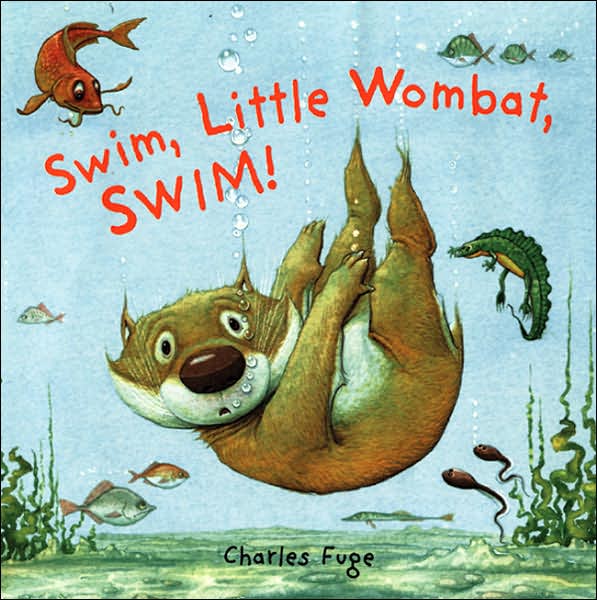
Submitted by Larisa Martin, Public Library of Charlotte and Mechlenburg County (NC)
Shape Bee

Early Literacy Aside--Example: Before children learn letters, they learn shapes. Let them play with shapes to develop later letter knowledge. Flannel Board: Do Shape Bee on flannel board. See attachment for pattern Shape Bee pattern Craft Activity: You can use the pattern as a basis to have the children make their own Shape Bee. Early Literacy Aside--Empower: Wherever you go today, look for the letter B, on signs, in books, on products. Then you can do the same with other letters throughout the week.
Submitted by Erin Nguyen, Public Library of Charlotte and Mechlenburg County (NC)
Way Down Deep in the Deep Blue Sea by Jan Peck
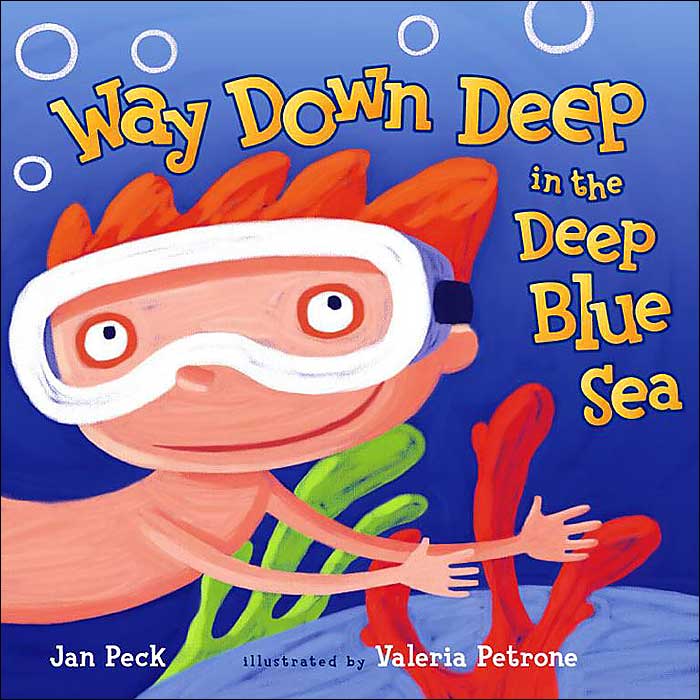 Introduction: I am going to read our next book, Way Down Deep in the Deep Blue Sea by Jan Peck. Then you can tell it with me on the flannel board.Read Way Down Deep in the Deep Blue Sea. Repeat some of the rhymes to help them remember.
Flannel Board: As you put up pieces on the flannel board have the children retell the story.
Early Literacy Aside--Example: Using the flannel board pieces as a clue will help your child remember the story to retell it. Encouraging your children to retell stories helps them to both remember and to understand them. It is a first step in helping them to later understand what they will read.
Introduction: I am going to read our next book, Way Down Deep in the Deep Blue Sea by Jan Peck. Then you can tell it with me on the flannel board.Read Way Down Deep in the Deep Blue Sea. Repeat some of the rhymes to help them remember.
Flannel Board: As you put up pieces on the flannel board have the children retell the story.
Early Literacy Aside--Example: Using the flannel board pieces as a clue will help your child remember the story to retell it. Encouraging your children to retell stories helps them to both remember and to understand them. It is a first step in helping them to later understand what they will read.
Submitted by Stem Saunders, Steele Creek Library, Public Library of Charlotte and Mechlenburg County (NC)
Itsy Bitsy Spider Rhyme
 Early Literacy Aside--Explain: Talking with children as you read books and share rhymes can add to the words they know and to their knowledge if YOU use words they are not familiar with or add information they may not yet know. Both adding to their vocabulary and to their knowledge will help them understand what they read when they learn to read. Say/sing the rhyme with actions:
The itsy bitsy spider went up the waterspout.
Down came the rain and washed the spider out.
Out came the sun and dried up all the rain.
And the itsy bitsy spider climbed up the spout again.
Early Literacy Aside--Example: Here are some examples of the kinds of questions you can ask your children. Then add to what they say to introduce new words and information. [Then you ask the children a couple of questions. Some possibilities are below. Be careful to keep it fun and engaging, not like a test of knowledge.]
Where was the spider going?
What happened when the rain started?
Where do you think spiders live?
Have you seen a spider? Where? What was it doing?
What do you know about spiders?
Early Literacy Aside--Empower: Sometimes we do not know much about some of the topics our children are interested in. We have lots of factual books on a variety of topics like spiders, snakes, dinosaurs, trains, and more. Just let us know what you and your children would like to read about. These books not only make reading enjoyable because yuou are building on your child's interest, you are also setting a good foundation for helping them learn new words and knowledge.
Early Literacy Aside--Explain: Talking with children as you read books and share rhymes can add to the words they know and to their knowledge if YOU use words they are not familiar with or add information they may not yet know. Both adding to their vocabulary and to their knowledge will help them understand what they read when they learn to read. Say/sing the rhyme with actions:
The itsy bitsy spider went up the waterspout.
Down came the rain and washed the spider out.
Out came the sun and dried up all the rain.
And the itsy bitsy spider climbed up the spout again.
Early Literacy Aside--Example: Here are some examples of the kinds of questions you can ask your children. Then add to what they say to introduce new words and information. [Then you ask the children a couple of questions. Some possibilities are below. Be careful to keep it fun and engaging, not like a test of knowledge.]
Where was the spider going?
What happened when the rain started?
Where do you think spiders live?
Have you seen a spider? Where? What was it doing?
What do you know about spiders?
Early Literacy Aside--Empower: Sometimes we do not know much about some of the topics our children are interested in. We have lots of factual books on a variety of topics like spiders, snakes, dinosaurs, trains, and more. Just let us know what you and your children would like to read about. These books not only make reading enjoyable because yuou are building on your child's interest, you are also setting a good foundation for helping them learn new words and knowledge.
Submitted by a library staff person at Public Library of Charlotte and Mechlenburg County (NC)
Catch That Goat by Polly Alakija
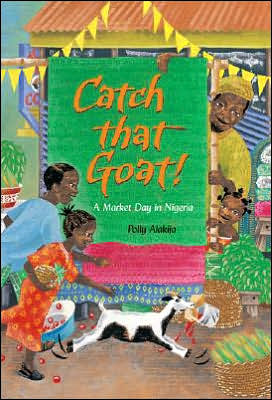 Early Literacy Aside--Explain: Today we're going to highlight narrative skills. This is the ability to describe things and to talk about events and tell stories. Researchers have noted this skill as one of the early literacy skills that will help your child be ready to read. It helps children understand what they will read.Read Clay Boy by Mirra Ginsburg
Flannel Board of Three Billy Goats Gruff
Early Literacy Aside--Example: In Catch That Goat we're going to say part of the story together. Acting out or repeating parts of stories helps children internalize and understand what is happening in the story. This will help them tell the story back to you, especially with their favorite stories which they like to hear over and over again. OK, now, let's all say together, "Have you seen my goat?" and "No!" Great!
Read Catch That Goat
Song: "Spaghetti Legs" on Jim Gill Sings the Sneezing Song and Other Contagious Tunes
Rhyme: 1, 2, 3, 4, 5 Once I Caught a Fish Alive
Read Oh, Look by Patricia Polacco
Early Literacy Aside--Empower: Today we read some of my favorite stories. Practice telling and retelling stories. If you let your child watch television, talk about the shows you watch together. Have them tell you what happened in the show. This will help them talk aout what is happening in books also. Talking about what they know and retelling events and stories helps them understand what is being read.
Early Literacy Aside--Explain: Today we're going to highlight narrative skills. This is the ability to describe things and to talk about events and tell stories. Researchers have noted this skill as one of the early literacy skills that will help your child be ready to read. It helps children understand what they will read.Read Clay Boy by Mirra Ginsburg
Flannel Board of Three Billy Goats Gruff
Early Literacy Aside--Example: In Catch That Goat we're going to say part of the story together. Acting out or repeating parts of stories helps children internalize and understand what is happening in the story. This will help them tell the story back to you, especially with their favorite stories which they like to hear over and over again. OK, now, let's all say together, "Have you seen my goat?" and "No!" Great!
Read Catch That Goat
Song: "Spaghetti Legs" on Jim Gill Sings the Sneezing Song and Other Contagious Tunes
Rhyme: 1, 2, 3, 4, 5 Once I Caught a Fish Alive
Read Oh, Look by Patricia Polacco
Early Literacy Aside--Empower: Today we read some of my favorite stories. Practice telling and retelling stories. If you let your child watch television, talk about the shows you watch together. Have them tell you what happened in the show. This will help them talk aout what is happening in books also. Talking about what they know and retelling events and stories helps them understand what is being read.
Submitted by Vera Beers, Public Library of Charlotte and Mechlenburg County (NC)
We're Going on a Bear Hunt by Michael Rosen
 Early Literacy Aside--Explain: Teddy Bear puppet talking to introduce the skill: Today we are going to develop your children's story knowledge and thinking skills. These skills help them to understand what they read when they learn to read. [Then hide the bear in a black piece of paper like a cave.]Read We're Going on a Bear Hunt, putting motions to the words.
Activity: Give children colored stips of paper to represent each of the scenes in the book. Connect each color strip with each scene; for example: blue for river, green for grass, brown for mud. Now, retell the story using first, second, third, etc.--first we went to the river and as they say the phrase they place the blue colored strip down, and so on. For the last action where they go home, have a piece of material to represent a blanket.
Early Literacy Aside--Example: With this activity what your child knows, by helping them in a couple of ways--retelling the story so they understand how stories work and also with sequencing and connecting colors with actions which develops their thinking skills.
Early Literacy Aside--Explain: Teddy Bear puppet talking to introduce the skill: Today we are going to develop your children's story knowledge and thinking skills. These skills help them to understand what they read when they learn to read. [Then hide the bear in a black piece of paper like a cave.]Read We're Going on a Bear Hunt, putting motions to the words.
Activity: Give children colored stips of paper to represent each of the scenes in the book. Connect each color strip with each scene; for example: blue for river, green for grass, brown for mud. Now, retell the story using first, second, third, etc.--first we went to the river and as they say the phrase they place the blue colored strip down, and so on. For the last action where they go home, have a piece of material to represent a blanket.
Early Literacy Aside--Example: With this activity what your child knows, by helping them in a couple of ways--retelling the story so they understand how stories work and also with sequencing and connecting colors with actions which develops their thinking skills.
Submitted by Irania Patterson, Public Library of Charlotte and Mechlenburg County (NC) and Saroj Ghoting
